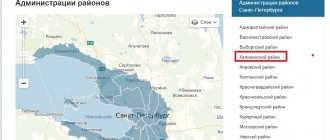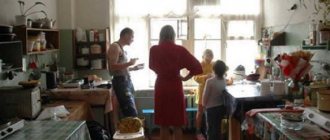Home / Real estate / Housing rights
Back
Published: 10/22/2016
Reading time: 10 min
0
784
In St. Petersburg there is a program for the resettlement of communal apartments.
It works to improve the living conditions of owners and tenants of communal apartments with the assistance of the city administration.
- What is this program
- The terms of participation
- Types of government assistance
- What kind of housing can you get?
- How the program works
- How to participate in the program
- Resettlement process and calculation of social benefits
What is this program
It does not provide for the provision of new apartments.
Citizens are paid a subsidy that covers part of the cost of purchasing housing if:
- The participant lives in a communal apartment, which is subject to resettlement.
- As a result of the transaction, the communal apartment turns into a separate one.
In 2021, more than 3 billion rubles have been allocated from the city budget for the implementation of the resettlement program. This will help approximately 4,645 families.
Administration of the Posadsky municipal district
Institution data
| Name of the organization | Administration of the Posadsky municipal district |
| What area is it located in? | Petrogradsky |
| Region of Russia | Saint Petersburg |
| Organization phone number | +7 show phone |
| Website | https://www.mo60.ru |
| [email protected] | |
| Organization address | St. Petersburg, Bolshaya Posadskaya street, 4 |
| Opening hours | no information |
The terms of participation
To participate in this program you must simultaneously:
- Live in an apartment included in the list of communal apartments subject to resettlement.
- Be registered as needing housing or assistance in improving living conditions.
For those in need of living quarters or their improvement, there are two queues. The first, general, includes:
- Living in St. Petersburg for 10 years or more.
- There is no more than 10 meters per person in an apartment if it is separate.
Residents of communal apartments are included in the waiting list, regardless of the size of the premises.
To get on the low-income waiting list, you must also have lived in the city for 10 years or longer.
The income per family member should not be more than twice the subsistence level.
The value of property that is subject to taxation should not exceed ten times the cost per square meter. Such property includes, for example, apartments, land, cars, etc.
In this case, one person should have no more than 9 square meters of housing in a separate apartment or 15 square meters in a communal one.
To register, you must submit an application to the housing department of the city administration, located at the place of permanent registration.
Where to go
You take the collected set of documents to the district administration at your place of residence. She hands over the papers to the Housing Committee. All apartments that are resettled with the help of the state must be included in the so-called consolidated list. It is compiled by the Housing Committee. If a positive decision is made regarding a citizen and his apartment is included in the list, then officials notify about this in writing within 30 days.
You can receive social benefits within two to three months, after your utility is included in the consolidated list. But relocating a communal apartment with the involvement of investors is not so easy. The wait may drag on for several years.
Types of government assistance
Assistance from St. Petersburg can be expressed in one of the following options:
- Providing cash subsidies for the purchase or construction of residential premises.
- Possibility to buy a room (rooms) in the same communal apartment using a reduction factor to the cost.
- Redistribution of rooms in communal apartments and individual apartments included in the housing stock.
Priority participation in other programs to improve living conditions (for example, in programs for public sector employees or young families). In this case, it is necessary that as a result of the transactions, the communal apartment becomes separate. It is possible to use a mortgage loan.
Administration of the Aptekarsky Island municipal district
Institution data
| Establishment | Administration of the Aptekarsky Island municipal district |
| In what area | Petrogradsky |
| In what region | Saint Petersburg |
| Web site | https://www.msapt-ostrov.ru |
| Address where it is located | St. Petersburg, Lev Tolstoy street, 5 |
| Institution phone number | +7 show phone |
| [email protected] | |
| Working hours | no information |
What kind of housing can you get?
Using the program, you can purchase housing in St. Petersburg or the Leningrad region.
It could be:
- Separate apartment or residential building.
- A room(s) in a communal apartment, if as a result of the transaction it becomes separate.
- Housing under construction, if it is at least 70% complete.
- An apartment in a housing construction or housing savings cooperative (provided that the construction of an apartment building is 70% or more completed).
In this case, the total area of the premises should not be less than the accounting standard for housing provision. It is determined by Law No. 409-61 of 07/07/2004 and is 18 sq. m of total area for each family member or 33 sq. m for single citizens.
Subsidies are not allocated for the purchase of housing:
- recognized as emergency;
- under bail or arrest;
- does not meet the requirements for residential premises;
- encumbered with rights of use by other persons, if they remain after the transaction.
Administration of the Chkalovskoye municipal district
Organization data
| Name | Administration of the Chkalovskoye municipal district |
| What area is it located in? | Petrogradsky |
| Organization website | https://mo-chkalovskoe.ru |
| [email protected] | |
| Organization phone number | +7 show phone |
| When it works | no information |
| Address where it is located | St. Petersburg, Bolshaya Zelenina street, 20 |
| In which region of Russia | Saint Petersburg |
How the program works
The following options for relocating a communal apartment are possible:
- The owners of the communal apartment sell all the rooms to one owner. Using the proceeds from the sale and subsidies from the city, they purchase separate housing.
- One of the residents of the apartment buys the remaining rooms, their previous owners purchase separate apartments (or residential buildings).
- If one of the rooms of a communal apartment is included in the housing stock or is vacated when living conditions are improved, a resident of the same apartment can buy it back with a reduction factor.
- Exchange of apartments and rooms in them, occupied by those on the waiting list or included in the housing stock.
- Resettlement at the expense of the investor. At the same time, the city pays 30% of the cost of housing, which makes the apartment more attractive to them.
The size of the reduction factor depends on the time during which the citizen is registered as in need of improved housing conditions:
- more than 15 years – 0.3;
- from 10 to 15 years – 0.4;
- from 5 to 10 years – 0.5;
- less than 5 years or not a member, but entitled to it - 0.6;
- for citizens who have merits to Russia and St. Petersburg – 0.4.
The cost of the room(s) is multiplied by the appropriate coefficient. Thus, a discount of 40–70% of the cost is possible.
Administration of the Vvedensky Municipal District
Organization data
| Name | Administration of the Vvedensky Municipal District |
| Area | Petrogradsky |
| [email protected] | |
| Address | St. Petersburg, Liza Chaikina street, 4/12 |
| Web site | https://www.mo58.ru |
| Operating mode | no information |
| Region | Saint Petersburg |
| Institution telephone numbers | +7 show phone |
How to participate in the program
To participate in the program, you must contact the housing department of the district administration in accordance with your registration address. It is also possible to register through the Multifunctional Center.
For this you will need the following documents:
- Applications from all residents of the communal apartment.
- Copies of identification documents.
- Copies of documents containing information about family composition (marriage, divorce, birth certificates).
- Confirming that citizens are registered for improvement of housing conditions.
- Certificate of registration (form 9).
- Characteristics of residential premises (form 7).
- Documents about the presence or absence of other housing in the property.
Long service pensions are issued to military personnel under certain conditions. Should working pensioners count on indexation of pensions after dismissal? Find out about it here.
What is the child tax credit and how is it paid in 2016? Details in this article.
Administration of the Kronverkskoye municipal district
Institution data
| Name of the organization | Administration of the Kronverkskoye municipal district |
| What area is it located in? | Petrogradsky |
| Operating mode | no information |
| Institution website | https://www.kronverkskoe.ru |
| [email protected] | |
| Organization address | St. Petersburg, Lenina street, 12/36 |
| Region | Saint Petersburg |
| Organization phone number | +7 show phone |
House with cracks
It’s a similar story in the Eastern District of Moscow. The communal apartment on 1st Vladimirskaya Street, 9a, makes an even more depressing impression. The facade of the house is covered with cracks - just like in Bykov’s film “The Fool”.
“Look, the bricks are ‘walking,’” resident Orkhan Huseynov points to strange dents and bulges on the façade. “This means they don’t sit securely and can fall out.” It's most likely due to the humidity."
Previously, the house was a military hospital, then in the same way it was transferred to a reinforced concrete structures plant for a dormitory. The rooms were separated by plasterboard partitions, and the operating room was converted into a kitchen. As if a reminder of that time, in the middle of the kitchen there is a huge table - but a cutting table.
The walls were painted quite recently, but literally after a few days the paint began to peel off in eerie gray-green rags. “The painters came and are painting something. I say: “Lord, you should at least brush off the dust.” They: “We paint as they pay,” complains Anna Bugorkova.
For children, residents also built a makeshift shower on the site of one of the toilets. To wash in it in winter, two heaters are turned on here. “In general, we bathe children depending on the weather,” says Gulnur Irkulaeva, who lives in a communal apartment with her husband and three children.
Anna Bugorkova also washes her 82-year-old mother “depending on the weather.”
The residents of this communal apartment agree to another area, and even to moving outside the Moscow Ring Road while maintaining their registration - “as long as they live like people,” but their five-story building turned out to be not dilapidated enough to participate in the “miracle program.”
And there are many such “undesirable” communal apartments in Moscow. But the calls of their residents do not reach the Moscow authorities.
The scale of the communal problem
Communal apartments in the familiar form are a relic of the Soviet era . Initially, they appeared as the Bolsheviks’ answer to the housing question - working-class families began to move into multi-room apartments (the so-called densification). This happened after private ownership of housing and land was abolished. Thus, the concept of a communal apartment is already about 100 years old, but they still exist in Russia.
Living in one apartment for several families at once brings many difficulties - a shared kitchen and other amenities, the possibility of conflict situations, and difficulties with selling such real estate.
Now communal apartments are a problem mainly in St. Petersburg and, to a lesser extent, in Moscow. In other cities, such housing is currently found in isolated cases.
Officially, the problem of communal apartments is raised only at the regional level, and a full-fledged program for their resettlement exists only in St. Petersburg.
It is worth distinguishing a communal apartment from an apartment in which several families simply live. In order for an apartment to become a communal apartment, the families’ shares must be allocated in kind, and each family must have its own personal account.
The problem of communal apartments in Russia remains large-scale, although no one keeps records of them at the state level. From various sources you can collect the following data on their quantity:
- in St. Petersburg as of 2021, there were 71.8 thousand communal apartments, and 233 thousand families live in them;
- in Moscow in 2014 there were 72 thousand communal apartments and 180 thousand families living in them;
- in other cities – statistics are not kept.
The problem of relocating communal apartments is usually solved in several ways:
- purchase of all rooms by one buyer;
- purchase by one tenant of the remaining rooms;
- social benefits for families in need of resettlement;
- providing housing to those in need in accordance with the law;
- exchange of rooms, etc.
Many communal apartments were resettled in the 90s - they were located mainly in the old building, which was of interest to realtors and their clients. In Moscow, only from 1991 to 1998, the number of communal apartments was halved - from 240 to 120 thousand.
After 2004, it became impossible to create new communal apartments - amendments to the Housing Code now prohibit the separation of personal accounts. And in Moscow, since 2006, city authorities have not been able to accommodate those in need of housing.











